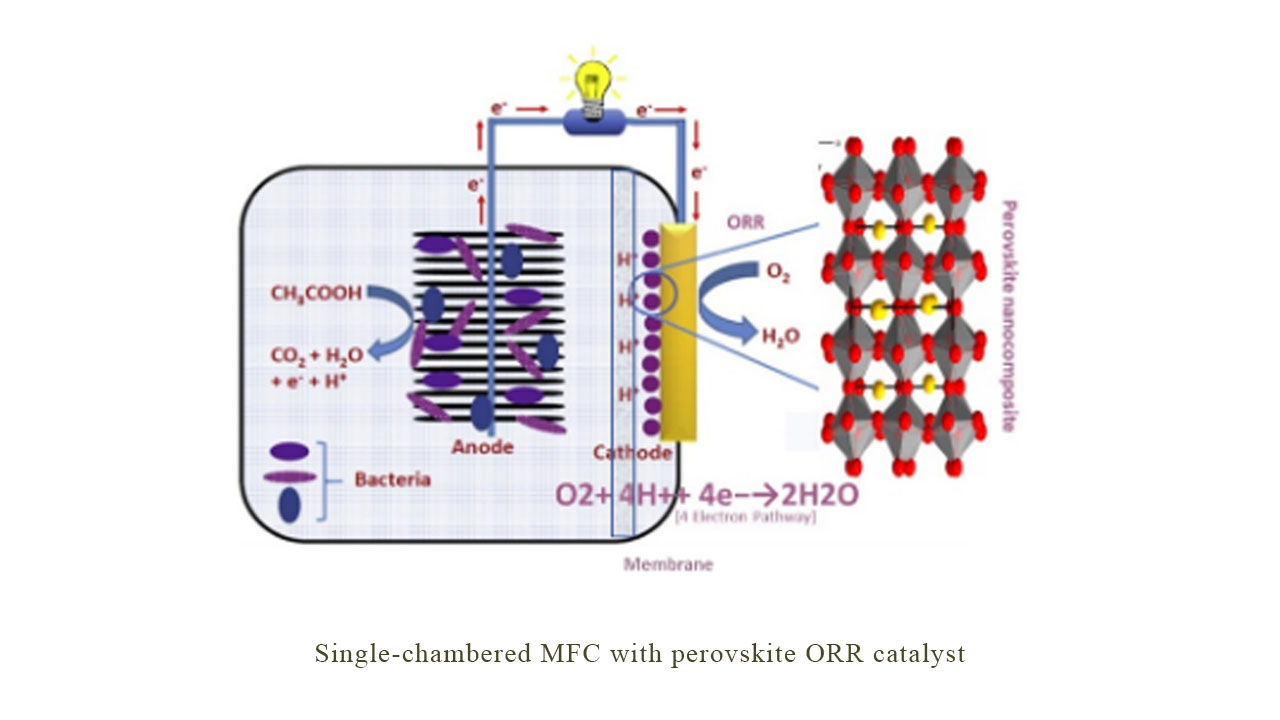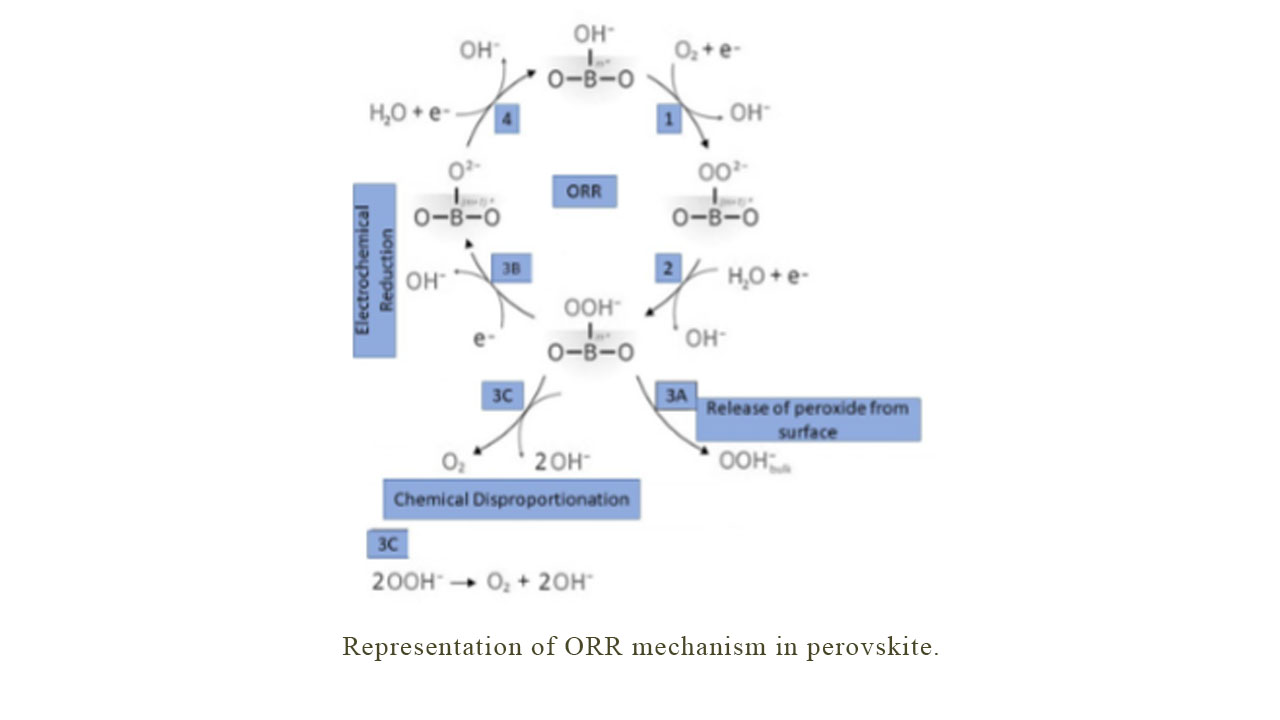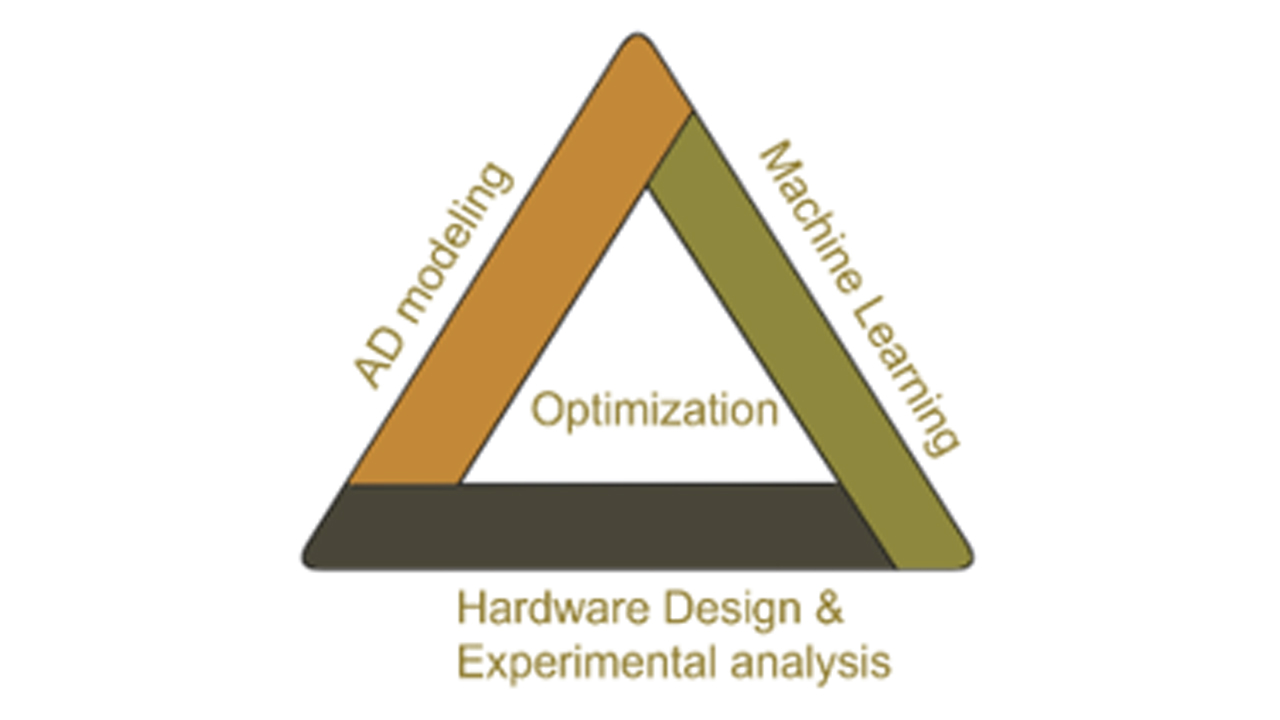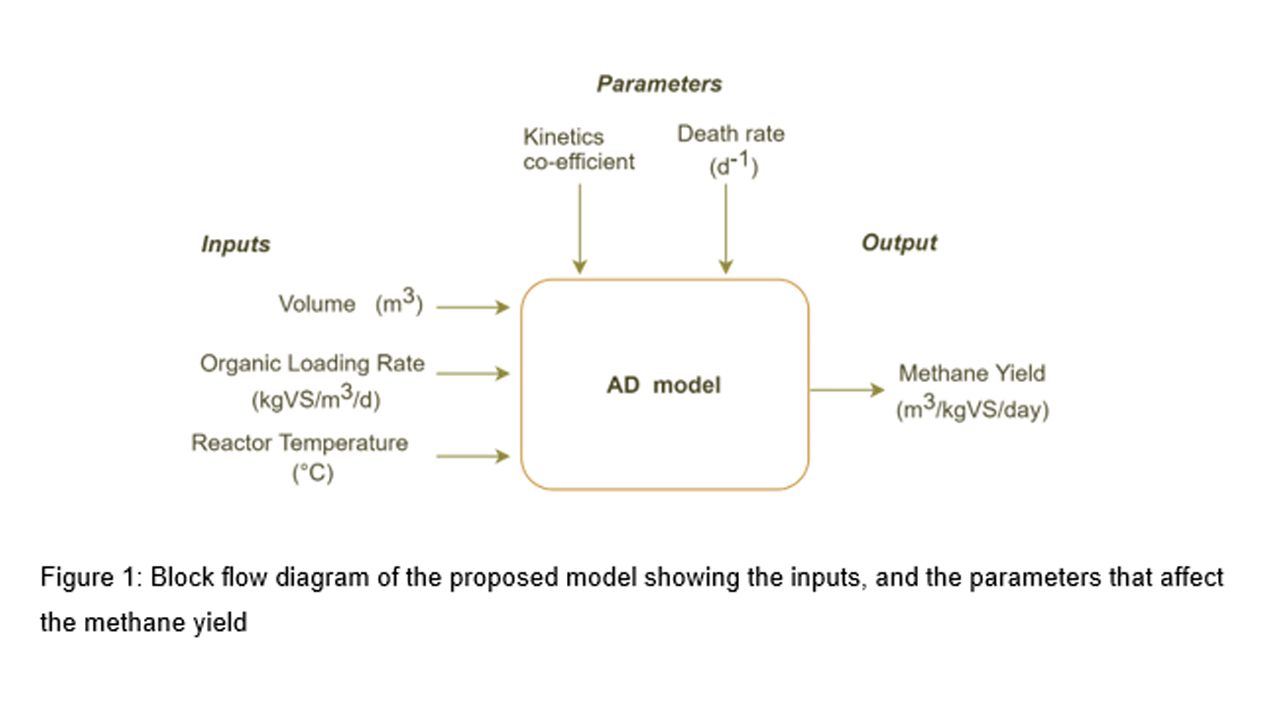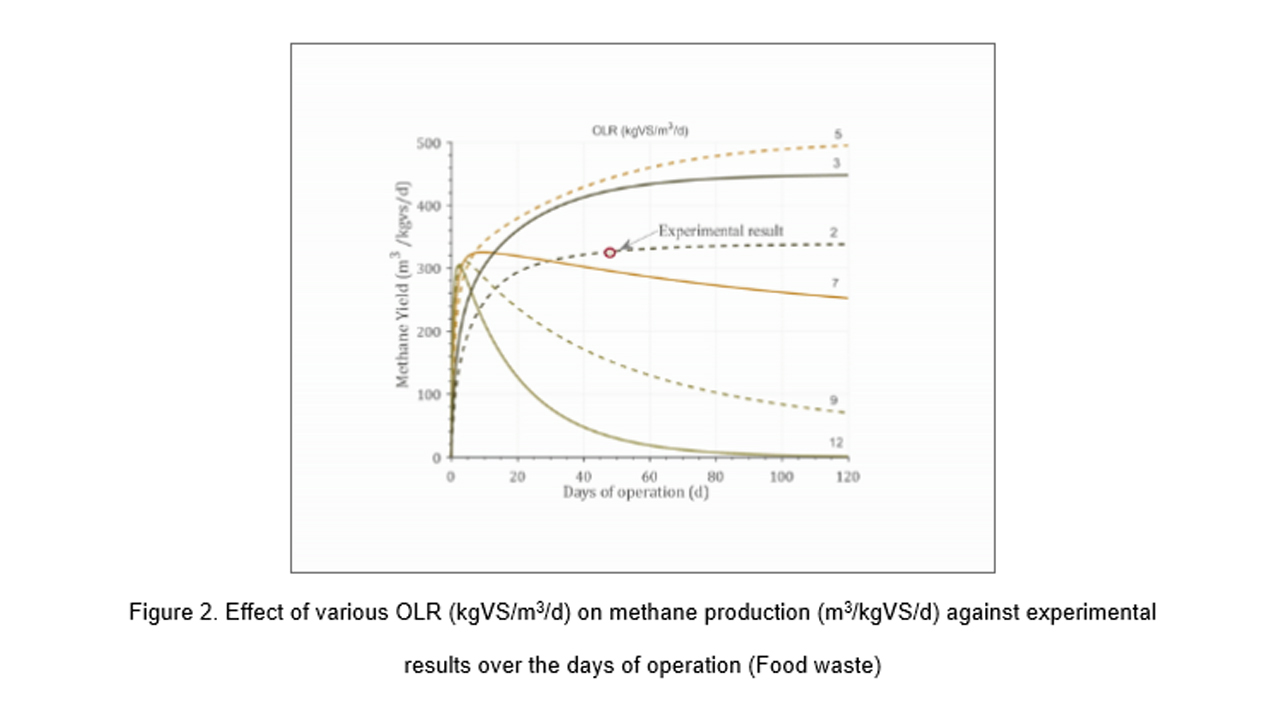Introducing perovskite-based catalyst for microbial fuel cell
Microbial fuel cells (MFCs) are biochemical systems producing green energy through the microbial degradation of organic contaminants in wastewater. The Oxygen Reduction Reaction (ORR) that takes place at MFC cathode decides the overall output of energy generation. Hence, the selection of ORR catalyst becomes pivotal in MFC fabrication for its efficiency and cost effectiveness. Gopa Nandikes P, PhD Scholar, Department of Environmental Science, proposes perovskite-based nanocatalyst as an excellent replacement to Platinum in his paper “Perovskite-Based Nanocomposite Electrocatalysts: An alternative to Platinum ORR Catalyst in Microbial Fuel Cell Cathodes”. The paper is published in ‘Energies Journal’ having an Impact Factor of 3.04.
The paper comprehensively summarises all the studies conducted with perovskite-based ORR catalyst in MFC, its unique reaction mechanism and the synergistic effect with carbon. The paper also throws light into various challenges and prospects to further improve the ORR activity of perovskite-based catalysts.
Abstract of the Research
Microbial fuel cells (MFCs) are biochemical systems having the benefit of producing green energy through the microbial degradation of organic contaminants in wastewater. The efficiency of MFCs largely depends on the cathode oxygen reduction reaction (ORR). A preferable ORR catalyst must have good oxygen reduction kinetics, high conductivity, and durability, together with cost-effectiveness. Platinum-based electrodes are considered a state-of-the-art ORR catalyst. However, the scarcity and higher cost of Pt are the main challenges for the commercialization of MFCs; therefore, in search of an alternative, cost- effective catalysts, those such as doped carbons and transition-metal based electrocatalysts have been researched for more than a decade. Recently, perovskite-oxide based nanocomposites have emerged as a potential ORR catalyst due to their versatile elemental composition, molecular mechanism, and the scope of nanoengineering for further developments. In this article, we discuss various studies conducted and opportunities associated with perovskite-based catalysts for ORR in MFCs. Special focus is given to a basic understanding of the ORR reaction mechanism through oxygen vacancy, modification of its microstructure by introducing alkaline earth metals, electron transfer pathways and the synergistic effect of perovskite and carbon. At the end, we also propose various challenges and prospects to further improve the ORR activity of perovskite-based catalysts.
- Published in Departmental News, ENVS News, News, Research News
Accelerating research in the Quantum-dot Cellular Automata domain
The Department of Electronics and Communication Engineering is glad to announce that our PhD scholar, Mr Vasudeva Bevara and BTech students, Mr Shakamuri Narendra Chowdary and Mr Bolem Venkata Surendra Babu, published a paper titled ‘High performance 2n: 1: 2n Reversible MUX/DEMUX Architecture for Quantum-dot Cellular Automata’ in the international journal ‘Numerical Modelling: Electronic Networks, Devices and Fields (SCI Index)’ under the supervision of Dr Pradyut Kumar Sanki.
Abstract of the Research
Quantum-dot Cellular Automata (QCA) lead to fundamental changes in nanoscale technology. It promises small area, low power & high-speed structures for digital circuit design. This paper presents efficient low power structures of Reversible Multiplexer & Demultiplexer (RMD) modules based on the QCA technology. The simulation result shows that the proposed RMD modules have utilised less area & low power consumption. The simulation, layout & energy dissipation analysis of the proposed RMD module has been carried out using the QCA Designer-E simulation tool.
Essentially, CMOS is used as a well-known traditional technology in the design of the Very Large-Scale Integration (VLSI) circuits, which leads to the introduction of QCA as new nanotechnology to overcome the limitations of CMOS technology, such as material, physical, power, heat & economic challenges.
In reversible computation, the power dissipation occurs only when the computation is started or when the output is permanently stored. The reversible logic circuits are being investigated to prevent data loss in irreversible logic circuits. The reversible logic circuits provide zero loss of energy/information making the logic circuits the most suitable for QCA nanotechnologies. This has resulted in widespread interest in the design of reversible logic circuits based on QCA over the last few years.
In this paper, a modular 2n: 1 reversible multiplexer & 1: 2n reversible demultiplexer design in a single circuit is proposed. The 2:1 multiplexer & 1: 2 demultiplexer is realised in a single module i.e., 3 × 3 RMD. The 3 × 3 RMD is formed fundamental building block of the modular 2n: 1 reversible multiplexer & 1: 2n reversible demultiplexer design is extended to large RMD design.
Practical Implementations of the Research
This work can push forward research in the QCA domain and overcome the limitations of Complementary Metal Oxide Semiconductor (CMOS) technology. Soon the era of Beyond CMOS will start as the scaling of the current CMOS technology will reach the fundamental limit. QCA (Quantum-dot Cellular Automata) is the transistor less computation paradigm and viable candidate for Beyond CMOS device technology.
So, they have implemented the High Performance 2n: 1: 2n Reversible MUX/DEMUX Architecture for Quantum-dot Cellular Automata compared to other researcher works. In future, the research team would like to explore deeper into QCA technology and design efficient circuits which are small sized, with less cell count and less power consumption.
- Published in Departmental News, ECE NEWS, News, Research News
Supercapacitor electrodes for enhanced energy storage
The Department of Physics is happy to announce that Prof Ranjit Thapa and his PhD Scholar Mr Samadhan Kapse have published a paper titled “Supercapacitor electrodes based on quasi-one-dimensional van der Waals TiS3 nanosheets: experimental findings and theoretical validation” in the Nature indexed journal ‘Applied Physics Letters’ having an impact factor of 3.79. The Paper is published in collaboration with Abhinandan Patra and Chandra Sekhar Rout from Jain University and Dattatray J Late from Amity University.
Abstract of the Research
To cease the ever-increasing energy demand, additional enthusiastic focus has been given to generate more sustainable energy from alternative renewable sources. The storage of these energies for future usage solely depends on the energy storage devices. A diversity of electrode materials based on two-dimensional (2D) transition metals and their derivatives have enticed the whole world owing to their tunable properties. Transition metal trichalcogenides (TMTCs- MX3 type) is the emergent class of 2D materials that gathered a lot of interest because of their quasi-one-dimensional anisotropic properties with the van der Waals force of attraction in between the layers. Herein, TiS3 being an MX3-type of material is preferred as the electrode for supercapacitor application with detailed experimental investigations and theoretical validation. The highest capacitance attained for TiS3 is found to be 235 F/g (105 C/g) at 5 mV/s with a battery type of charge storage mechanism. The asymmetric device is fabricated using Ti3C2Tx MXene nanosheets as negative electrode and a brilliant 91 % of capacitance retention is accomplished with an extensive potential window of 1.5 V. The investigational discoveries are substantiated by theoretical simulation in terms of the quantum capacitance assessment and charge storage mechanisms.
About the Research
In this work, a battery type TMTC material i.e., TiS3 has been synthesized and characterized by different analytical techniques such as Raman spectroscopy, FESEM and TEM to gain information on its structural and morphological aspects. The electrochemical performance was found to be promising by considering its good energy storage performance. High capacitance of 235 F/g (105 C/g) at 5 mV/s was achieved and the asymmetric supercapacitor devices disclosed outstanding cycling stability of 91 % over 6000 GCD cycles. In addition, the theoretical simulations also validated the experimental findings through the evaluation of the quantum capacitance. The higher conductivity, abundant electrochemical active sites, swift faradic redox kinetics and well-connected pathway for ion transfer characteristics pave the way for TiS3 to emerge as an eminent material for energy storage application in the long run.
Social Implications
Energy storage devices come into picture whenever there is a prerequisite of storing renewable energy. Among the numerous energy storage devices, batteries and ultracapacitors have acquired more popularity in nanotechnology and optoelectronics field. The high stability, accuracy, swift functionality, power density and reversibility are the key factors that have positioned ultracapacitors at the forefront of all energy storage devices. On the contrary, the low energy density and high cost of supercapacitor electrodes try to put them in the back seat of the wheels of the energy industry. Henceforth, in recent times the development of supercapattery (abbreviated for supercapacitor and battery) types of materials has become a way out which tie the aces like high specific power of supercapacitors with the high energy density of batteries. These materials exhibit capacitive or battery type behaviour on the basis of materials properties, electrolytic ions, design of the electrochemical cell. Due to these advantages and superior energy storage performance, the demand for this kind of material is growing.
Theoretical quantum capacitance is an important parameter to investigate the supercapacitor performance of low dimensional materials such as electrodes. This approach is highly cost-effective for the rapid screening of various materials for supercapacitor applications.
- Published in Departmental News, News, Physics News, Research News
Optimising the anaerobic digestion process
Publishing a paper in the second-best journal in the discipline of Environmental Engineering and having an impact factor of 9.7 is obviously a significant achievement. The Department of Environmental Science is elated to inform you that the paper, “Dynamic Simulation and Optimization of Anaerobic Digestion Processes using MATLAB” has been published by Dr Karthik Rajendran, Assistant Professor of Environmental Science, and his PhD student, Mr Prabhakaran G in ‘Bioresource Technology’ journal.
Abstract of the research
Time series-based modelling provides a fundamental understanding of process fluctuations in an anaerobic digestion process. However, such models are scarce in literature. In this work, a dynamic model was developed based on modified Hill’s model using MATLAB, which can predict biomethane production with time series. This model can predict the biomethane production for both batch and continuous processes, across substrates and at diverse conditions such as total solids, loading rate, and days of operation. The deviation between the literature and the developed model was less than ±7.6%, which shows the accuracy and robustness of this model. Moreover, statistical analysis showed there was no significant difference between literature and simulation, verifying the null hypothesis. Finding a steady and optimized loading rate was necessary from an industrial perspective, which usually requires extensive experimental data. With the developed model, a stable and optimal methane yield generating loading rate could be identified at minimal input.
About the research
Anaerobic Digestion (AD) is a natural process that converts organic waste into biogas, in the absence of oxygen, which can be used as cooking fuel or for electricity generation. Biogas generation depends on various operational parameters of the AD processes like temperature, organic loading rate, and pH. For example, the speed of a car depends on various parameters like mileage per litre, type of fuel (petrol or diesel), engine power, type of gear, and road type. The optimum speed of a car can be defined by the manufacturer. Likewise, the optimum biogas/ biomethane can be calculated by computer simulations. If the loading rate is increased, the biogas yield increases up to a particular time and then decreases due to overloading like human bodies (eating a large amount of food may strain or cause failure of the digestive system), then the biogas plant will be a failure.
Optimising the loading rate through experiment was not easy, as multiple trials were necessary and it will take a longer time and high cost. In this work, the researchers did the optimisation based on the loading rate over the time period. The loading rate was optimised to maximum methane production, which also showed the region of stability from an operational perspective.
Practical implementations of the research
The practical implications of this work are, to use it in real-time operations of an AD plant and in research laboratories to estimate the best region of operation in terms of loading rate and yield. This work shows that longer days of operation could optimise better loading rates or could help in reaching a steady-state condition in real-time biogas plants.
Future research plans
Real-time biogas plants are deficient in the availability of data to do the computer simulation by using the mathematical model. To overcome this problem, researchers are planning to do Artificial Intelligence (Machine learning)- based biogas prediction by data-driven techniques. It will reduce the complexity with higher accuracy. In future, the machine learning model will integrate with real-time bioreactor for self-diagnosis and better decision making.
- Published in Departmental News, ENVS News, News, Research News
Do you think CSIR-JRF is a tough nut to crack? Persistence is the key

“Believe you can and you’re halfway there.” – Theodore Roosevelt
Jesni M Jacob, currently doing research under Dr Mahesh Kumar Ravva narrates her journey to achieving CSIR-JRF All India Rank of 65 through persistent efforts.
I’m working in the field of computational chemistry on designing and developing organic molecules for OLED applications. Securing an AIR of 65 in the CSIR JRF in Chemical Science June 2021 exam is a dream come true moment for me.
In 2019, I completed my post-graduate studies at Madras Christian College, Chennai. The four-year-long journey from zero to JRF AIR 65 was of hard work, patience, sleepless nights, sacrifices and even frustrated moments. It was challenging to remain motivated after multiple unsuccessful attempts. But I wasn’t ready to give up hope. I believed in myself and dreamed big with faith in God Almighty.
My previous attempts didn’t provide me with any hope of continuing my preparation because my marks were consistently far below the cutoffs. That made me realise one thing: without coaching and ample guidance, qualifying for CSIR JRF is a toiling task for an average student. But I learned that with strong passion, proper dedication, and right strategies of do’s and don’ts, any aspiring student can pass the exam with flying colours.
After each attempt, I learned from my mistakes and tried to optimise my strategies. One should never try to cover the entire syllabus and be bothered about it. I analysed the unit-wise weightage and narrowed it down to a few important topics that I found exciting and comfortable.
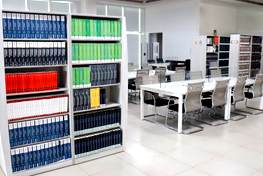
- Choose topics carefully and focus solely on mastering them.
- Try to stick to and rely on reliable standard textbooks as much as possible.
- The SRMAP library provided me with excellent access to a wide range of standard texts.
The JRF aspirants should try to solve previous years’ questions from standard exams (CSIR, GATE, IISc, etc.) and note new concepts or approaches every day. Enjoy and prepare short notes with a lot of scribbling and highlighting in various colours. Notes should be concise and simple to revise later. But don’t spend too much time making notes.
I made time for exam preparation along with my work and research activities. I’m grateful to my family, teachers, and especially my guide- Dr Mahesh Kumar Ravva, for their constant support and encouragement. He gave me a safe space to express my desire to ace the exam and my anxieties about it. Dr Mahesh always listened to my concerns and helped me to gain clarity on my thoughts. He always encouraged me to dream big and shared his perspectives and lessons from his life experiences. He is a great mentor, motivator, and teacher to me.
- Published in Blog, Chemistry-news, Departmental News, News, Research, Students Achievements
Presenting our first doctorate holder: Dr Vasavi Dutt
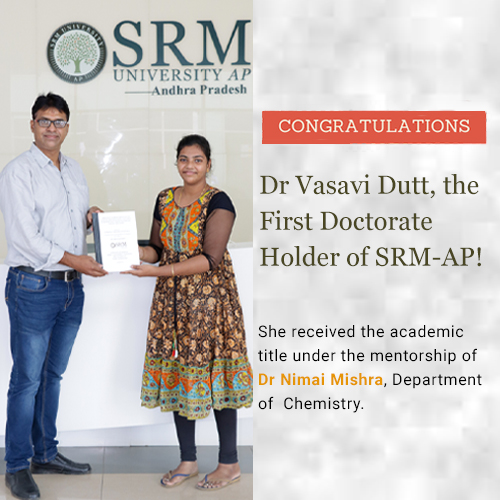 The university revels in its monumental achievement of bringing out the maiden doctorate degree holder, Dr Vasavi Dutt, within four years of its inception. Dr Vasavi Dutt enrolled as a PhD scholar in the Department of Chemistry, under the supervision of Dr Nimai Mishra, Assistant Professor, in 2018. She received the academic honour for her research thesis titled “Improvement of Photoluminescence and Achieving the Stabilization of Cesium Lead Halide Perovskite Nanocrystals for Light-emitting Applications”. Dr Vasavi has been an extremely diligent student and she mustered up immense courage to bring her research to closure even during the testing times of the pandemic.
The university revels in its monumental achievement of bringing out the maiden doctorate degree holder, Dr Vasavi Dutt, within four years of its inception. Dr Vasavi Dutt enrolled as a PhD scholar in the Department of Chemistry, under the supervision of Dr Nimai Mishra, Assistant Professor, in 2018. She received the academic honour for her research thesis titled “Improvement of Photoluminescence and Achieving the Stabilization of Cesium Lead Halide Perovskite Nanocrystals for Light-emitting Applications”. Dr Vasavi has been an extremely diligent student and she mustered up immense courage to bring her research to closure even during the testing times of the pandemic.
In the words of Dr Nimai Mishra, “It was a great privilege for me to supervise Ms Vasavi, (correct me Dr Vasavi now) as my first PhD student. She joined my research lab in July 2018 when there was no lab at all, and we started our work at Chemistry BTech Lab”. Dr Mishra was gleaming with pride as he spoke more about his scholar, “During these three and a half years, I had relentless scientific discussions with Vasavi which enriched both of us. Her attitude towards research was remarkable, whenever I gave her a research problem, she used to come up with a detailed outline of how to go ahead with the project”. He also praised her for all her accomplishments which include the publication of 13 research papers, filing of 3 patents and winning the best poster in national & internal conferences.
Dr Vasavi also shared her happiness for having received the mentorship of Dr Mishra, “Working in Dr Nimai Mishra’s lab was a great experience. I had the opportunity to engage and initiate multiple research topics and collaborations. He has always encouraged me to explore new fields to broaden perspectives and bring together new ideas”. She also expressed her gratitude to him for being a welcoming and approachable mentor. “I’m eternally thankful to Dr Mishra for his friendship, empathy, and moreover, for his great sense of humour”. She currently resides in the US with her family. Now that she has successfully completed her PhD, soon she would start looking for a job or rather pursue a post-doctoral fellowship in America.
Dr Vasavi was out of words to thank the university for facilitating and bringing the best in technology and infrastructure for advanced research. “I can never thank my university enough for extending a hospitable environment and nutritious food for all the doctorate students”, she further mentioned. The university serves as a promised land for thousands of research aspirants like her to head towards their dream of making unfeigned contributions to academia.
- Published in Chemistry-news, Departmental News, News, Students Achievements
C-SMILE: Pertinent feedbacks and effective learning
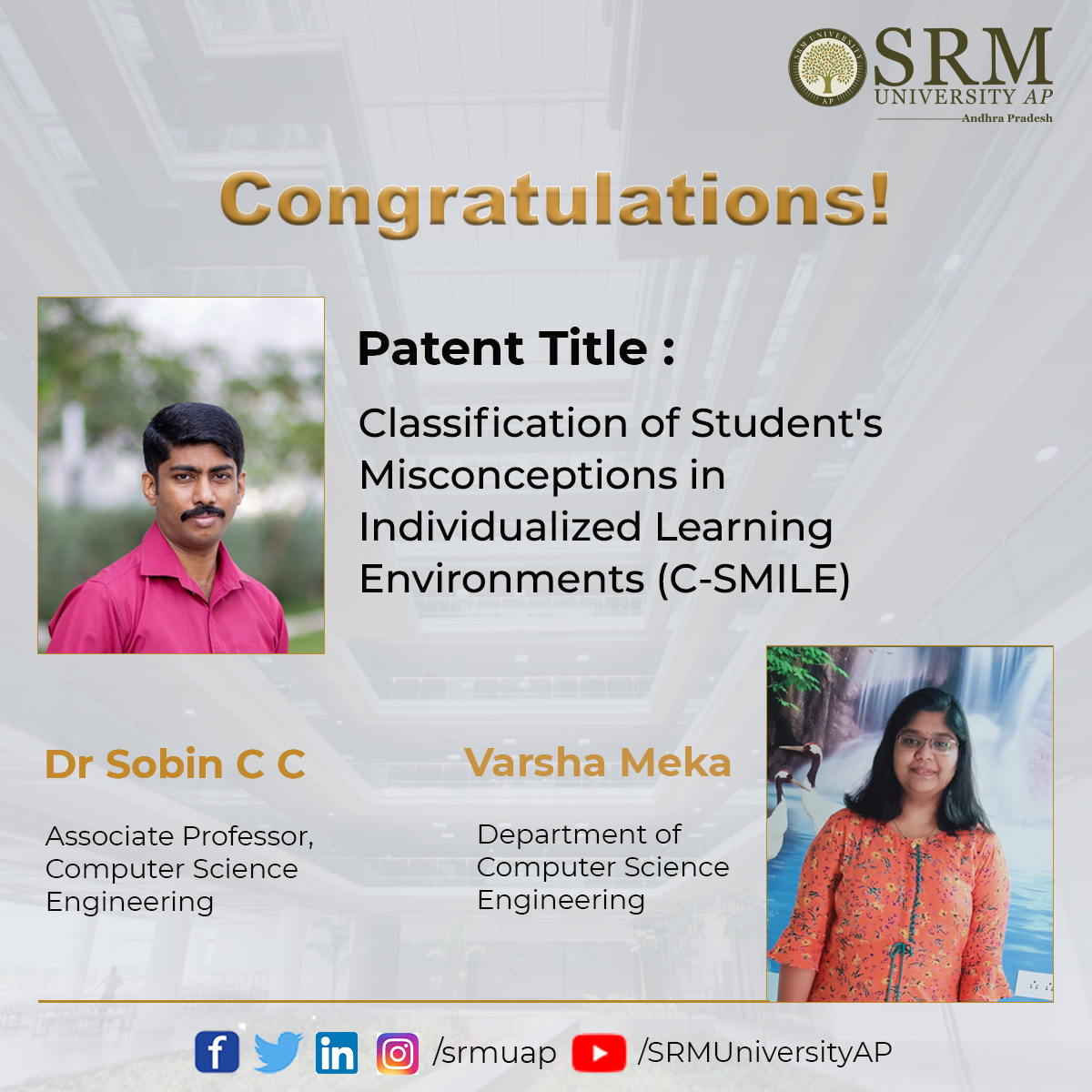
“The correct analogy for the mind is not a vessel that needs filling, but wood that needs igniting” – Plutarch
Where would you go to get the most appropriate feedback to improve your learning? Whom would you approach? An active learner requires continuous assessment. Exposure to relevant remarks can make a significant impact in the learning output. Choosing the right source of feedback is important to locate your position in the learning ecosystem. This is where C-SMILE enters the frame.
The Department of Computer Science and Engineering is delighted to inform you that the patent application (202241010415) entitled ‘Classification of Student’s Misconceptions in Individualized Learning Environments (C-SMILE)’ got published. The patent application was submitted by Associate professor Dr Sobin C C and BTech final year student Meka Varsha as part of the Capstone Project.
C-SMILE is an innovative platform which allows students to take assessment and receive feedback based on their performance and misconceptions. This targets to refine their conceptual and individualised learning. The platform offers the benefits of automated identification of misconceptions and classification of their level of conceptual clarity. This eventually leads to pertinent feedbacks and ensures quality learning. It also helps engineering educators to classify their students into different categories based on their level of conceptual clarity. Short quizzes and multi-level assessments can utilise the objective of this platform.
Dr Sobin C C and Meka Varsha have collaborated with Mr Subheesh N P from IIT Madras and Mr Jahfar Ali from IIT Hyderabad as part of this work. The team has already published 2 conference papers. One of them is in the prestigious IEEE Global Engineering Education Conference (EDUCON 2022), which is the flagship conference of IEEE Education Society.
The researchers are now working on to extend this concept to incorporate Bloom’s taxonomy to formulate more specific questions based on their level in the cognitive domain.
- Published in CSE NEWS, Departmental News, News, Research News
High gain boost converter fed inverter for better power supply
The Department of Electrical and Electronics Engineering is glad to announce that Dr Ramanjaneya Reddy, Assistant Professor; his students, Mr Rahul Kotana and Ms SK Hima Bindu have published a paper titled “High Gain Boost Converter Fed Single-Phase Sine Pulse Width Modulated Inverter” in the journal ‘International Journal of Renewable Energy Research’ having a Scopus site score of 4.2.
Abstract of the Research
A high gain boost converter fed single-phase voltage source inverter with its control for DC to AC power conversion in uninterrupted power supply and renewable energy applications is presented in this paper. The conventional DC-DC boost converter with a coupled inductor and switched capacitor is utilised to obtain high gain. Further, the output voltage of the inverter is controlled by the sinusoidal pulse width modulation technique. The detailed design and analysis of a high gain boost converter fed single-phase voltage source inverter is presented. The sine pulse width modulation control scheme for the voltage source inverter is also developed and presented. To validate the high gain boost converter fed single-phase voltage source inverter, the simulation model is developed in the LTspice software environment, and the results are validated. The results show high gain boost converter achieves a gain of about 10 and the single-phase voltage source inverter can provide an rms voltage of 228 V without using the step-up transformer. The total harmonic distortion of output current is found to be below 4.
About the Research
Energy is an essential factor for the functioning and economic development of the industrialized world. It plays a key role in our day-to-day life. On the other hand, energy management has become a critical factor for our successive economic prosperity. The energy consumption process frequently needs either DC-AC conversion or AC-DC conversion. The DC-AC conversion finds its major application in uninterrupted power supply (UPS) and renewable energy (RE). To supply during power outages, most UPS systems use batteries, usually lead-acid, as the storage mechanism. The battery is supposed to provide the backup in the absence of the grid supply. However, the voltage provided by the battery alone may not be enough to provide the backup. At first, the battery output power which is DC needs to be converted to AC with the help of an inverter. Apparently, the output of the inverter needs to be stepped up with the help of a step-up transformer to achieve an output of 220V 50Hz. An alternative approach to the same process is by using a power electronic converter called the DC-DC boost converter. The boosting of battery/PV voltage can be achieved with the help of a standard boost converter as shown in Fig. 1(b), or by using a battery capable of supplying higher voltage and a step-up transformer as shown in Fig. 1(a). High power batteries and step-up transformers can be eliminated if a high gain boost (HGB) converter is used instead of a standard boost converter. The HGB converter fed DC-AC conversion system is presented in this paper which eliminates the step-up transformer. The circuit configuration of the proposed work is depicted in Fig. 2.
Practical Implementations of the Research
The DC-AC conversion method proposed is based on the HGB converter fed single-phase SPWM inverter. The proposed model is best suited when a low voltage DC supply is available, and a standard 230V AC output is needed to deliver the load. The detailed design and analysis of the HGB converter are carried out, and the gain of the converter is achieved at around 10, which is very high compared with conventional boost converter topologies. A unipolar SPWM control scheme is developed in LTspice to control the single-phase VSI. The simulation results of the complete DC-AC conversion system are in close agreement with the design parameters. Further, the total harmonic distortion of the output current waveform is around 4% which is well below the international standards. In addition, the complete model consisting of both HGB converter and single-phase VSI are successfully simulated for an input of 36 V DC and produced an rms output voltage of 228 V.
In future, the DC-AC conversion method based on a high gain boost converter can be extended with the three-phase voltage source inverter with electric drive applications.
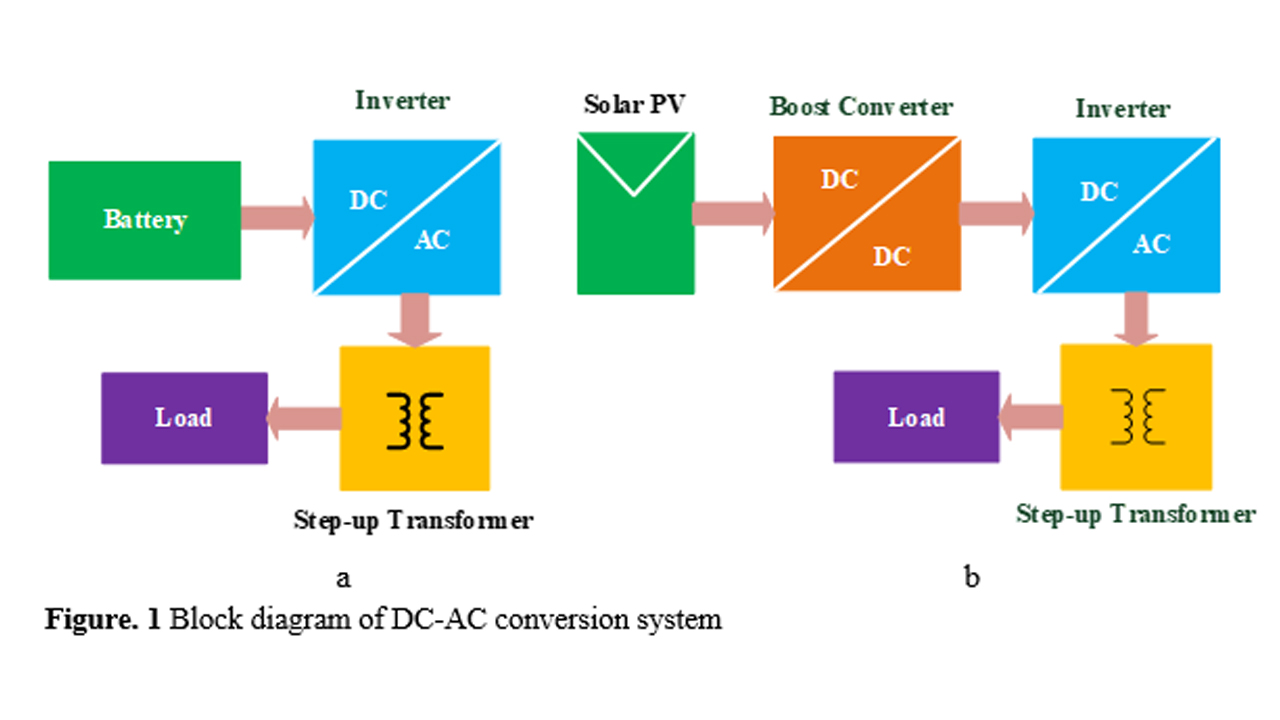
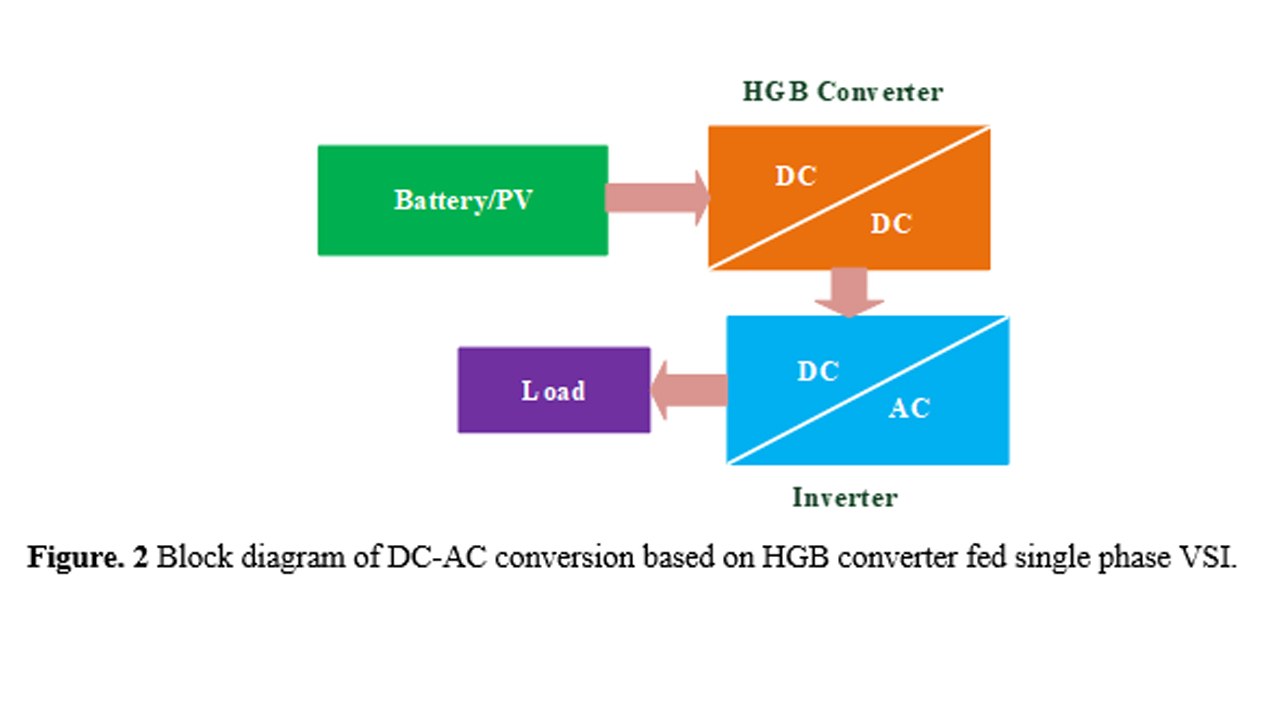
- Published in Departmental News, EEE NEWS, News, Research News
Unwinding the transgender travails
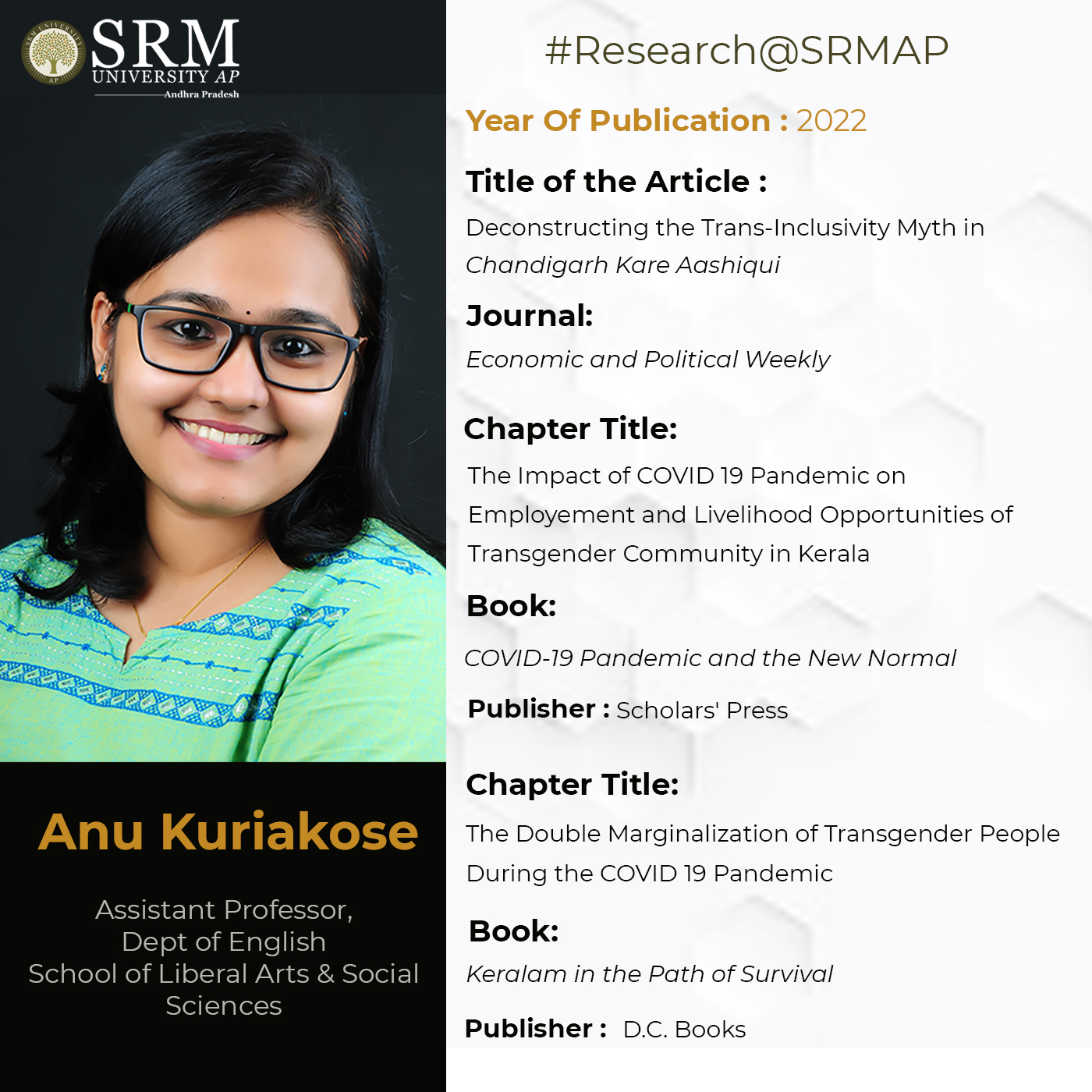
Embracing one’s transgender identity is a tremendous act of courage in a world that refuses to acknowledge their very existence. The narrations of their trials and tribulations continue to prevail despite the measures taken by the state machinery to assert their rights or the transgender revolution that spilt over in recent times. So long as the society continues to deny them a conducive space to exert their existence, the transgender community will have to endure hardships in all walks of life. The present-day researchers have increasingly shifted their focus on the LGBTQIA+ community to unravel their survival tales and awaken the population to their basic human rights.
Dr Anu Kuriakose, Assistant Professor from the Department of English, has also been looking into transgender lives and the anomalies in their representation. Her research analyses the inclusion and representation of transgender people in Indian films with a specific focus on the shift in representational politics and inclusive strategies in films of late. She has recently published a paper titled “Deconstructing the Trans-Inclusivity Myth in Chandigarh Kare Aashiqui” in the Economic and Political Weekly.
The article offers a critical reading of the Hindi film Chandigarh Kare Aashiqui (2021), which appears to maintain an inclusive outlook towards the queer community. Through the article, Dr Anu draws attention to the glaring presence of transphobic and homophobic attributes even in such progressive films. Her research attempts to analyse whether there have been any significant shifts in trans representation and inclusion in contemporary cinema.
She has also published two chapters, “The Impact of COVID 19 Pandemic on Employment and Livelihood Opportunities of Transgender Community in Kerala” and “The Double Marginalization of Transgender People During the COVID 19 Pandemic”, in the books COVID-19 Pandemic and the New Normal and Keralam in the Path of Survival respectively. The works recount the unspoken sufferings underwent by the transgender community in Kerala during the pandemic times. The chapters were co-authored by her peer, Dr Vinshi P K.
Her upcoming research plans include addressing gender diversity and inclusion in academic discourses in the vernacular of Kerala and critically reviewing the representational politics of trans femininity in visual cultural texts. By researching the portrayals of transgender community, Dr Anu intends to enhance awareness on the deviant representation of queer community in the realms of literature.
- Published in Departmental News, English Current Happenings, English news, News, Research News
Launching antenna-multiplexer for seamless IoMT connectivity
Dr Divya Chaturvedi, Assistant Professor, Department of Electronics and Communication Engineering, has come up with an exciting proposal for enhanced connectivity and high-speed data transmission across the Internet of Medical Things (IoMT) devices. Her research paper titled “Design of Antenna-Multiplexer for Seamless On-Body Internet of Medical Things (IoMT) Connectivity” has been published in the journal ‘IEEE Transactions on Circuits and Systems II: Express Briefs’, having an impact factor of 3.71. It was published in collaboration with Dr Arvind Kumar from Vellore Institute of Technology and Dr Imaculate Rosaline from Ramaiah Institute of Technology, Bangalore.
The research looks into the design and development of a multi-band self-triplexing antenna for Medical Things (IoMT) applications. The antenna is designed to operate at 5.2, 5.5 and 5.8 GHz and self-isolation is achieved below -23.9 dB. It also offers seamless communication links to other devices operating at the same frequencies. The designed antenna is cost-effective and compact in size, that can easily fit into any implantable medical device. To avoid the harmful effect of radiation, the SAR value should be <1.6 W/kg. The SAR for this antenna is achieved at 0.362 W/kg in a very simple profile. Due to its compact size, the antenna can be easily mounted in a wireless portable device. The self- triplexing property of the device also enables full-duplex communication between different devices in a single antenna. This design suggestively simplifies the density of the RF front-end subsystem and leads to a simple and efficient communication system.
Abstract of the Research
Here, a compact design of antenna-multiplexer is engineered specifically to meet the stringent requirement imposed by intricate subsystems operating at 5.2, 5.5, and 5.8 GHz frequency bands for Internet of Medical Things (IoMT) applications. The proposed design includes a hexagonal-shaped substrate integrated waveguide (HSIW) cavity, tripole-shaped radiating slot, tuning vias, and three inset microstrip feedlines. A tripole-shaped slot is imprinted on the top of the SIW. This slot subdivides the cavity into trio-radiating segments and each segment offers a single frequency band. Further, the frequency bands are tuned at 5.2/5.5/5.8 GHz. The design maintains mutual port isolation better than 23.9 dB. Compared with the conventional tri-frequency antennas, the proposed design is highly compact and doesn’t need any additional circuitry to improve the port isolations. The measured results confirm the expected performance of the design. Furthermore, the proposed antenna is optimized within an implantable medical device (IMD) and simulated inside a realistic Human Head model at a depth of 3 mm and the Specific Absorption Rate (SAR) value is estimated. The SAR values are well below 0.362 W/Kg at the functioning bands due to the unidirectional radiation pattern from the antenna.
Her future research plan includes designing and developing a cost-effective bra-like prototype of Antenna-Array Sensors for breast cancer detection.
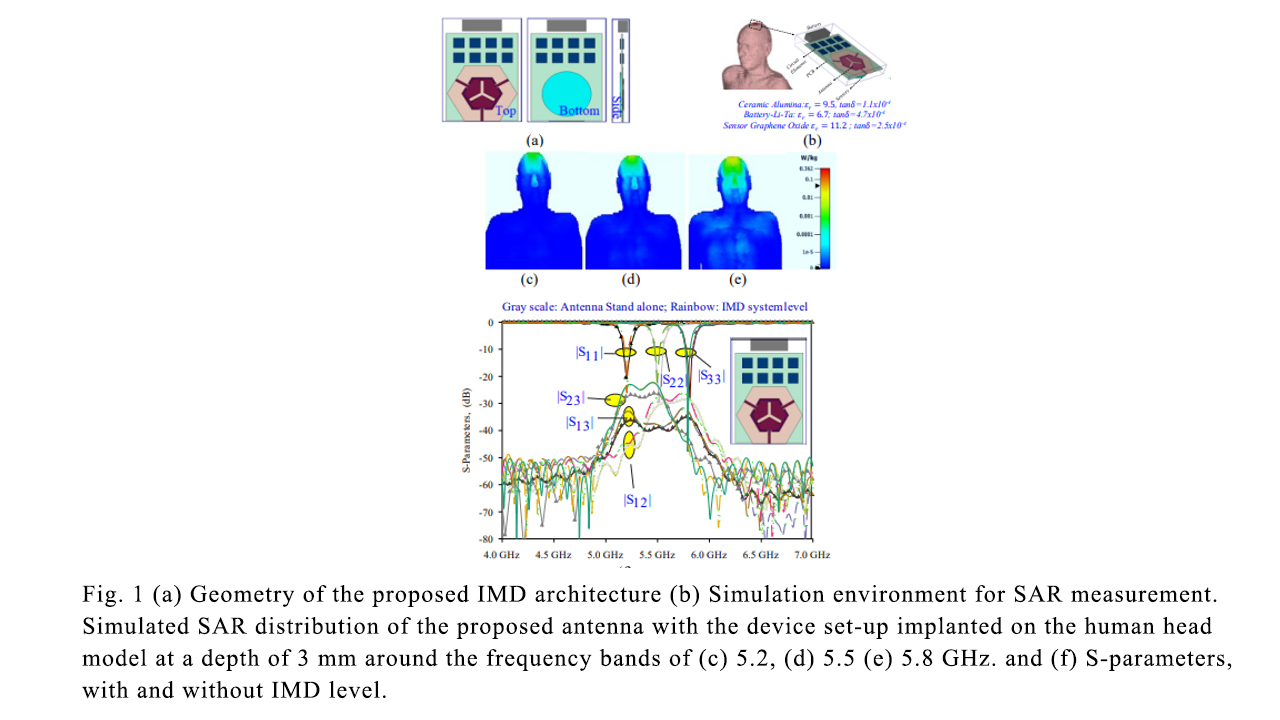
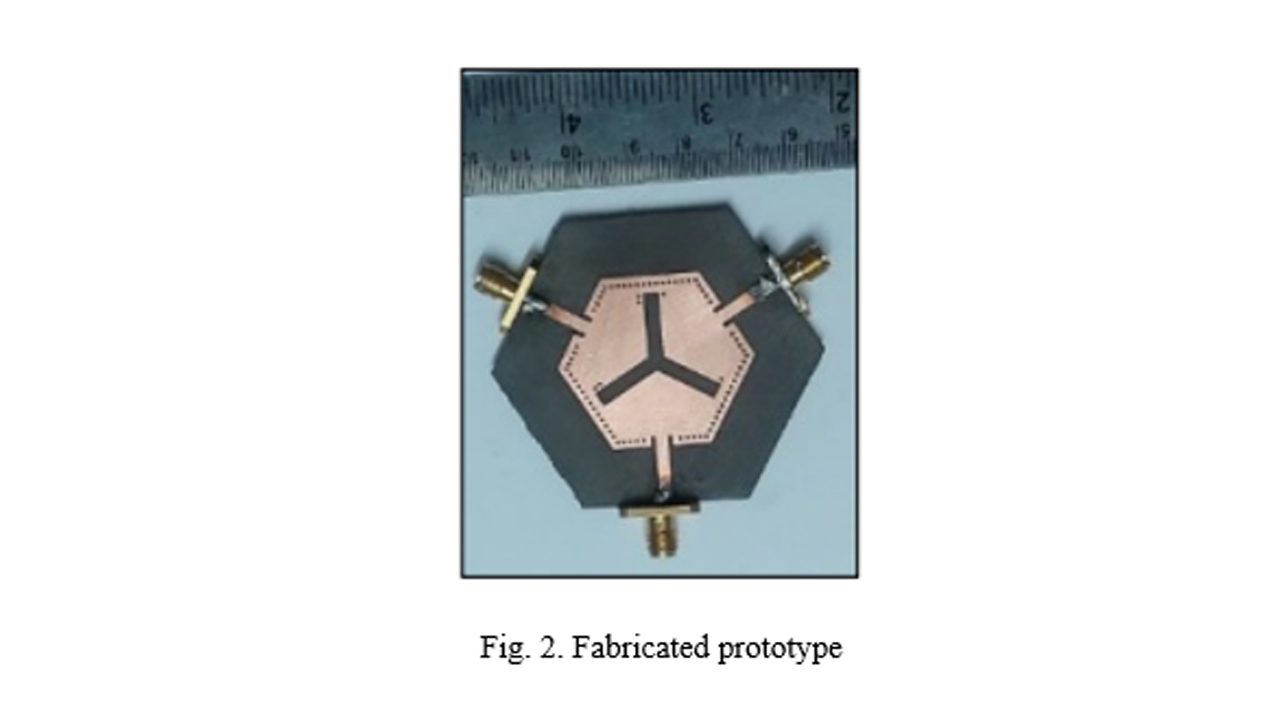
- Published in Departmental News, ECE NEWS, News, Research News


